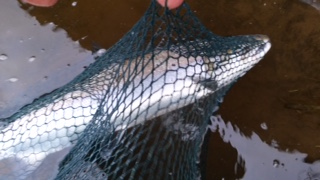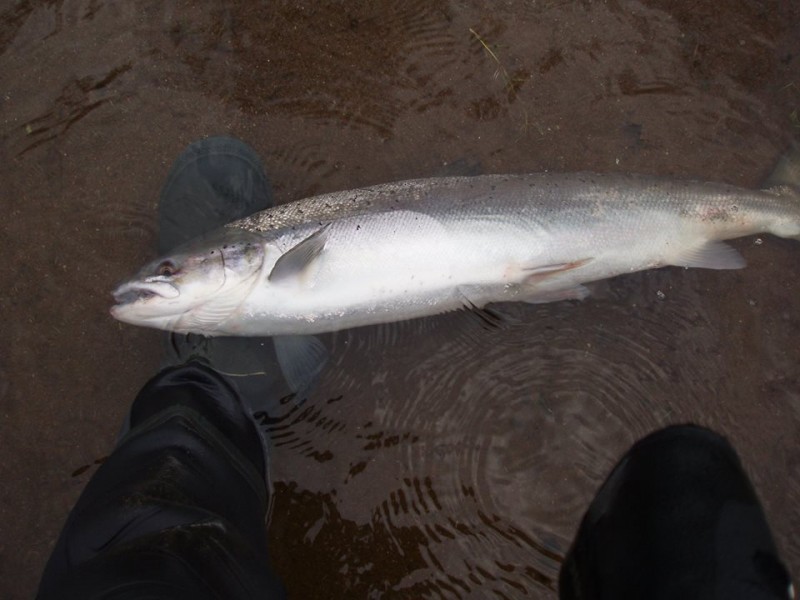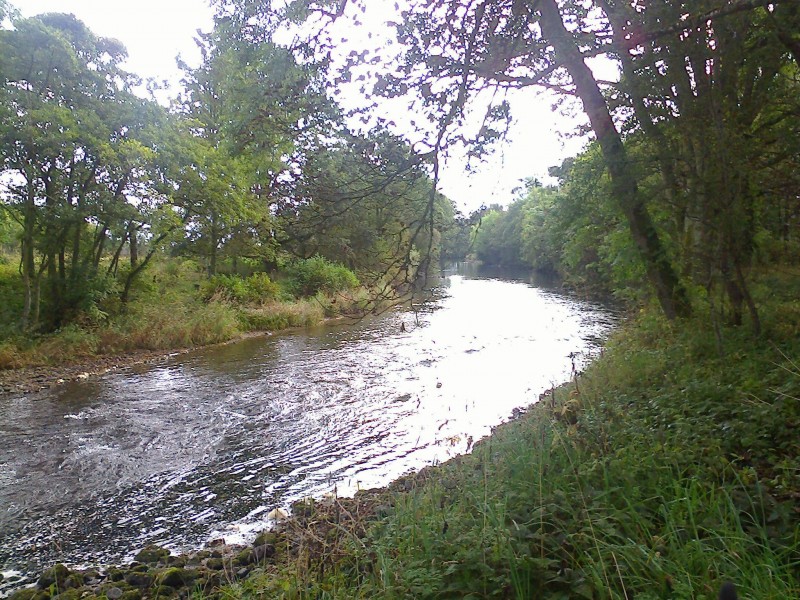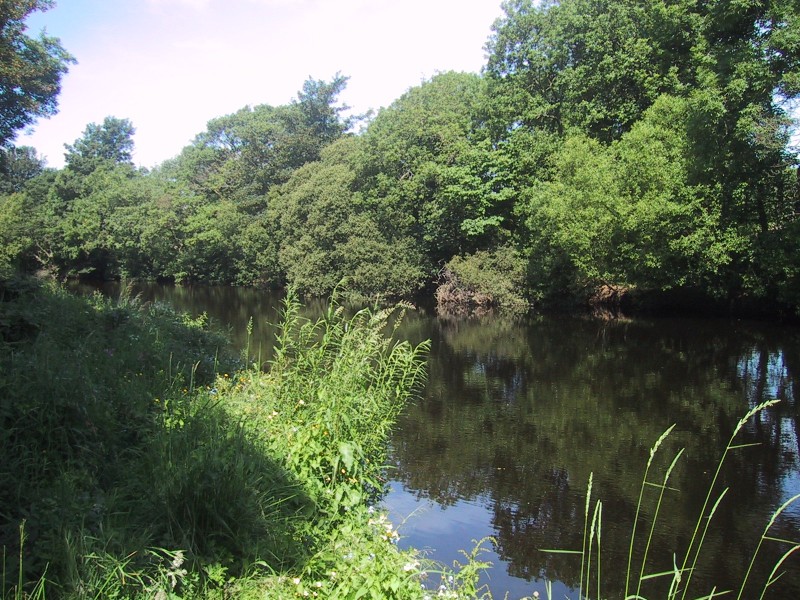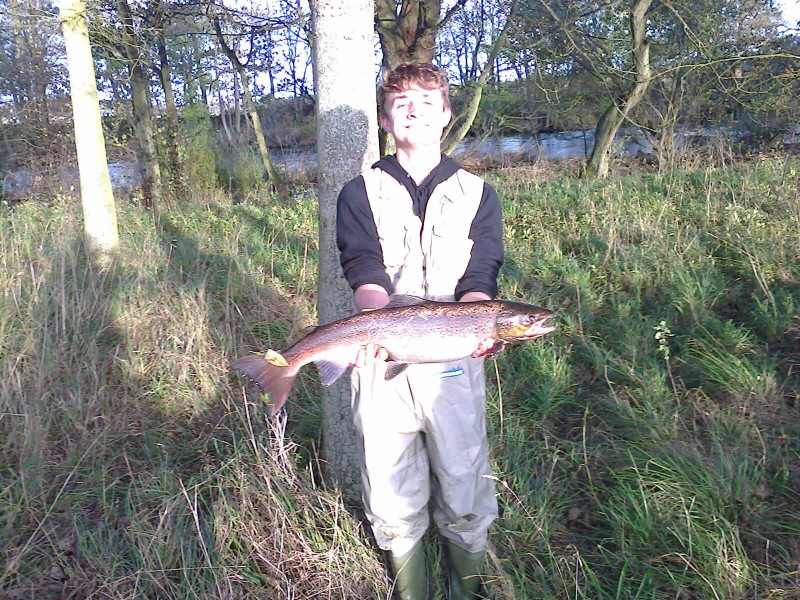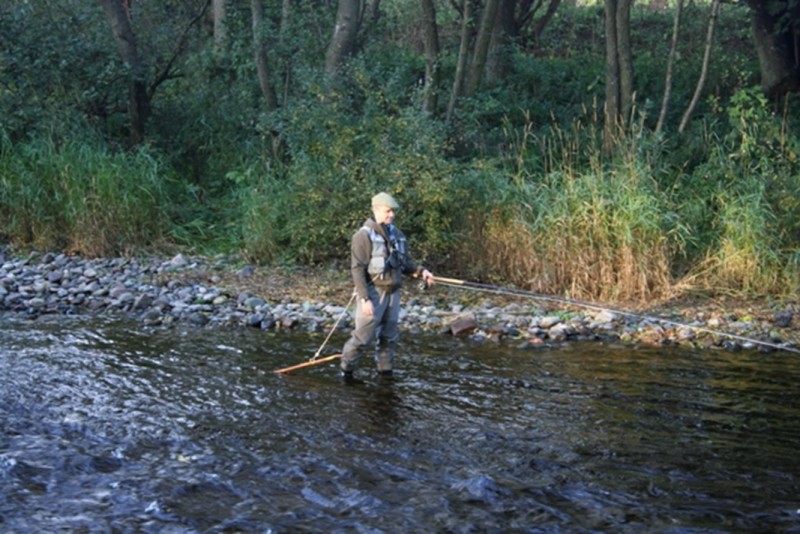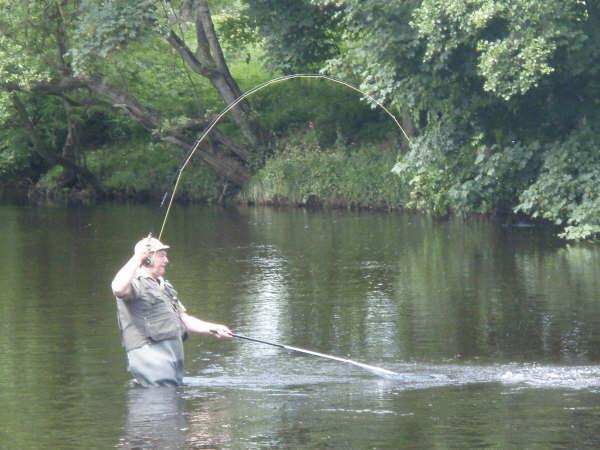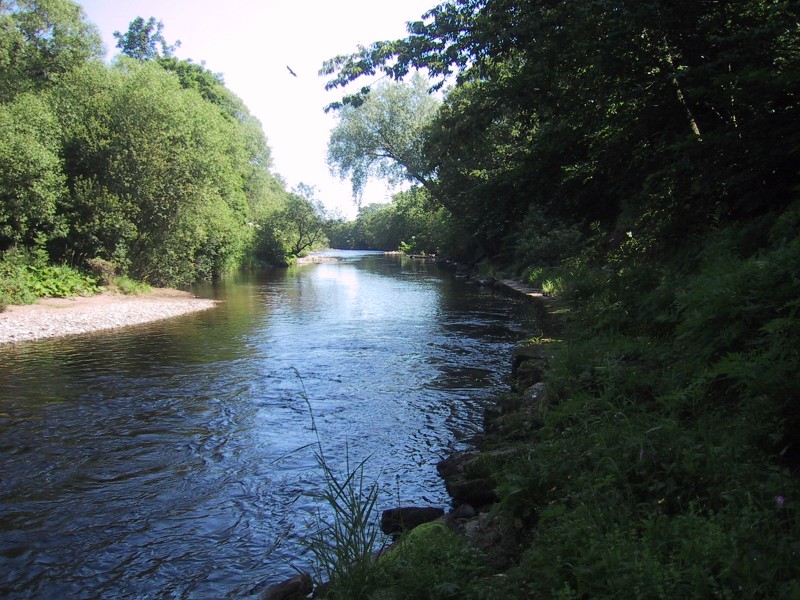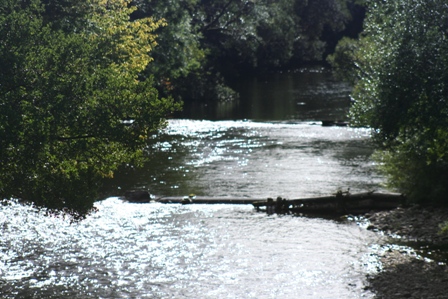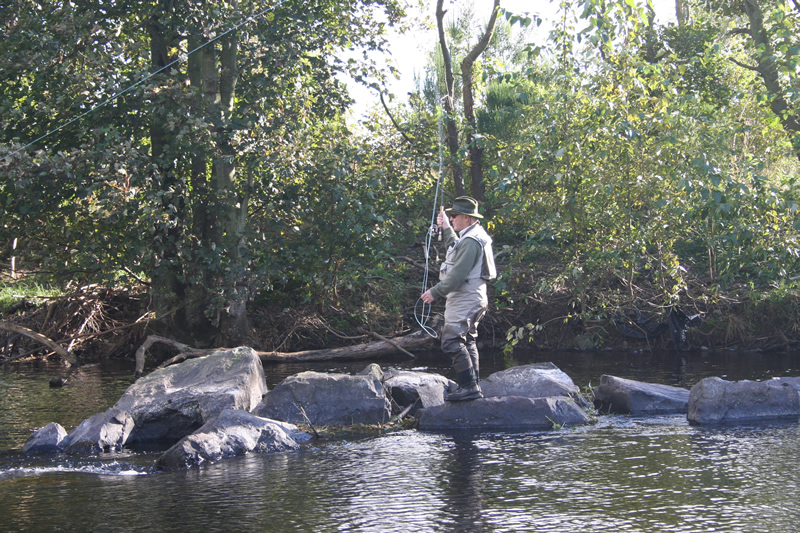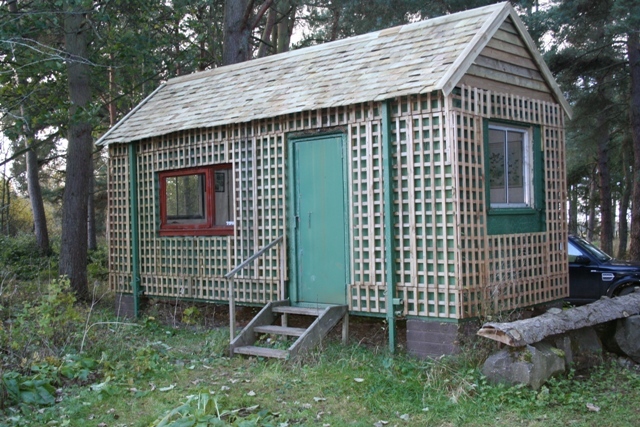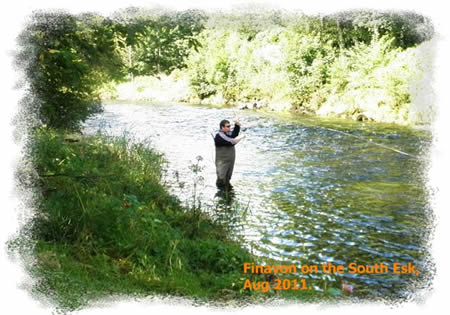Archive for the ‘Uncategorized’ Category
Memorable Summer Salmon
Tuesday, July 28th, 2015MID SEASON REPORTS FROM FCW
Sunday, July 26th, 2015SALMON CATCHES PICK UP IN THE LAST DAYS OF JULY
Today we caught and returned two grilse and three salmon, all of which were fresh from the sea. After last night’s better-than-expected news about the South Esk there is a spring in our step and renewed hope for the river. Two pristine, bright silver 12lbs salmon are the pictures that make a thousand words (photos coming soon).
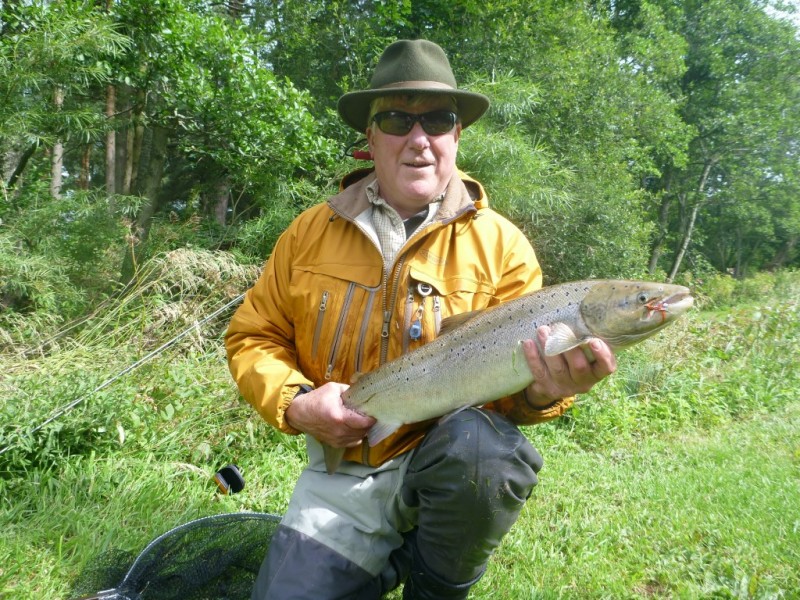 Gordon McCallum with a 12lbs salmon from Indies Beat’s Frank’s Stream
Gordon McCallum with a 12lbs salmon from Indies Beat’s Frank’s Stream
The river hasn’t fully recovered from last weekend’s mighty spate. The water is unusually cloudy which I suspect is coming from a major bank collapse somewhere upstream of Finavon. We are not seeing many fish, but there is undoubtedly a run going on.
Let’s see what the next few days bring….
TA 27/7/2015
THE NEWS IS GOOD: REPORT FROM ESK DISTRICT FISHERY BOARD MEETING ON 24 JULY 2015
the meeting tonight was very informative and there was even a note of optimism. John Armstrong of Marine Scotland gave an excellent summary of research on South Esk spring salmon from which it may be inferred that stocks are not as weak as we all feared he would report. The information on the tracking project was of particular interest, especially in the success of identifying where spring salmon spawn and where their juveniles grow.
While there is no room for complacency, it seems that recruitment of spring salmon juveniles in the upper reaches of the South Esk is encouraging. Nearer the sea the tributaries in the coastal plain – the Lemno Burn, Noran Water and Pow Burn are presenting very different data sets on densities and condition of salmon parr, with the Lemno Burn a really serious cause for concern, while the Noran is showing high densities of parr in good condition.
A perfect spring salmon from the South Esk at Finavon
John Armstrong recognised that angling effort has declined since 2009, but that catches per Unit effort have remained remarkably consistent over the last decade. It would appear that the decline of salmon in the South Esk may derive from a number of different sources, including a reduction in fishing effort and serious problems of recruitment of fry in the lower catchment.
The discussion with Marshall Halliday and Tom Sampson during the meeting was good natured to the extent that most of the concerns of anglers at the meeting were resolved. The decision of the government to institute a killing licence system for wild Atlantic salmon and to phase out all coastal netting throughout the country from 2016 provided a background to the meeting which could hardly have been better for a constructive discussion to follow.
My personal view is that this meeting confirmed things that many people who know and love the South Esk have felt intuitively or observed for some time. The people who manage the river, or whose jobs depend on its revival as a reputable salmon river and a top sea trout fishery, should feel reassured by these developments.
At last we have reason to smile and to make sure that these signs of optimism become substantial and sustainable. There is a lot of work to be done….
TA 25/7/2015
NOTES PREPARING FOR THE ESK BOARD MEETING ON 24/7/23015
Tomorrow at 1830 at the Northern Hotel in Brechin there will be a meeting organised by the Esk District Fishery Board. Among the speakers will be John Armstrong, who is the head of the Freshwater Fisheries laboratory at Pitlochry. It should be an interesting meeting which I hope will be well attended by an audience who come with open minds.
STOCK ASSESSMENT The raw data on the condition of salmon stocks in the North Atlantic Ocean is provided by an international organisation called ICES (international Conference for Exploration of the Seas). ICES collates returns from all the wild salmon countries of the North Atlantic based on catches and some other indicators.
The scientists and statisticians of ICES are all too aware of the limitations of using rod catch statistics as a primary tool on which to base management decisions, and they are currently looking at ways of improving their assessments. It is ICES that is telling us that numbers of salmon in the Ocean have declined from about ten million in the 1970s to under three million today. No-one is contesting that disastrous decline in abundance. Nor are any of the managers with whom I discuss such matters in the least bit complacent about the shortage of salmon in the South Esk. We recognise there are problems, as there are with other Scottish rivers, but we do need to improve our messaging and communications.
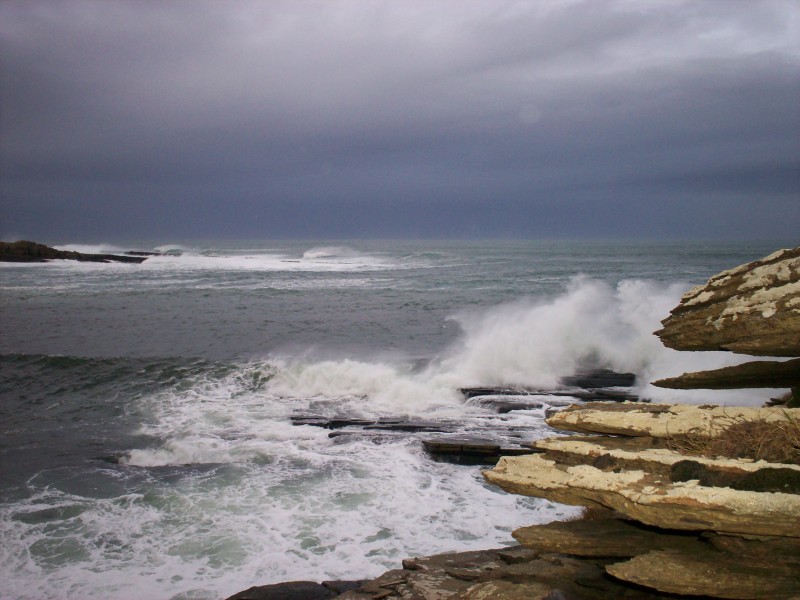 The wild Atlantic Salmon’ survival at sea is the biggest challenge for scientists. 40 years ago about 25% of smolts returned as adults. Today it is far less than 10%. This is the Pentland Firth in the far north of Scotland.
The wild Atlantic Salmon’ survival at sea is the biggest challenge for scientists. 40 years ago about 25% of smolts returned as adults. Today it is far less than 10%. This is the Pentland Firth in the far north of Scotland.
The Scottish Government uses the catch statistics tool to assess numbers of salmon spawners in each river. In the Esk District our fishery board applies the catch statistics tool religiously, and bases its management actions on the results, despite repeated claims by proprietors such as myself and anglers represented by their clubs, that restrictions on fishing methods, mandatory catch and release and a decline in angling effort are not being taken into account. I sometimes wonder if a nil return from a beat whose manager has decided not to fish at all would be treated by the board as an indication of stock decline. That has actually happened already with one well known middle beat. In other words a nil return means zero effort, no salmon caught. Logically, using the catches tool, without taking effort into consideration, means that the stock of the river will be described as having lower abundance.
I believe we need to encourage the fishery board to develop a more sophisticated way of measuring the river’s stock. It should for example not be too difficult to devise a crude method of measuring effort based on rod days fished in each month of the season. That would at least be a start!
Over time we can improve the way we measure angling effort and who knows? During that period we might even initiate an integrated stock assessment project using all the methods available to us, and not depend on one rather unreliable indicator on which to base our management decisions.
Perhaps tomorrow’s meeting might include a discussion on options for improving stock assessment, after we have heard the report from Marine Scotland.
TA 24/7/2015
MID SEASON REVIEW BY IAIN MACMASTER KEEPER AND GHILLIE AT FCW
Time passes quickly when you’re enjoying yourself, they say, and I certainly enjoy my outdoor life on the river. Time also seems to pass quickly when you observe the seasonal changes in nature. We are at the height of summer and the apex of growing season just now, the foxgloves are standing proudly alongside the melancholy thistles and campanulas. Within this seasonal label, however, there are observable changes almost daily. One notices how the shades of green on the trees deepens as they photosynthesise ever more quickly, and how the fruit on the grozet bush is suddenly ripe for picking even though the berries were hard and sour three days ago. This is the time of plenty, when our hunter gatherer forebears would have been collecting as much of nature’s larder as possible and drying or smoking it as a safety margin for the leaner time of year, which will be upon us before we know it. There is still yet a satisfying sense of ‘stocking up’ by picking fruit for jams and preserves and freezing trout.
Tyndals Pool on Milton Beat in low water
This is also the midway point of our fishing season on the South Esk. This season has been full of interest and excitement in equal measure. We have seen one of the best sea trout runs in recent memory which has been greatly encouraging. There have been times this season when we have observed shoals of fish numbering well into the hundreds in the pools at FCW. At the time of writing we have caught 134 of these wonderful creatures, most of which have been returned to continue their journey upstream; but some which have, quite rightly, been harvested for the hunter’s table. While the main run en-masse is beginning to peter out, we should still be picking fish up until the end of the season. I know that some fresh fish are still being caught further downstream and this too is encouraging. With any luck, there will be some good sport to be had with the ‘white trout’ for a
The famous Willows Pool on Milton Beat at sea trout time
Salmon fishing has been less prolific, but this isn’t too surprising considering that there has been little fresh water (until now) and that the bulk of angling effort has naturally gone into nocturnal forays for our aforementioned sea trout shoals. Right now, I am listening to the rain smashing off of the window panes like buckshot as it has been all night long. We are sure to have a river in full spate by tea time tonight and there will certainly be fish arriving on the back of it. Whether they will pause long enough on their journey for us anglers to catch a few next week remains to be seen, but they will be coming into the river and that is the important point. Good luck to those fish who steam straight through the beats, un seen by anglers and scarce stopping until they reach the pool in which they decide to hole up until, full of amorous intent, they emerge once again. Noble beasts they are!
First salmon. A happy customer!
By this time next month we will be beginning to think about early autumn fishing. The nights will be interminably drawing in, actually they already are! And most of the fruit will be just about gone, either into jam jars or back into the earth. Nature will be have dropped a gear and will be preparing to wind down. We, on the other hand, will be still going very much at full speed, trying to catch some of those lovely autumn salmon for which the South Esk is known. Let’s keep our fingers crossed for a good back end run!
IMCM 20/7/2015
My First Seventeen Months at FCW
Wednesday, April 22nd, 2015Iain MacMaster writes about his impressions of FCW and his first seventeen months looking after the fishery. Please make contact with Iain if you want to come and fish Finavon’s lovely pools. His mobile number is 07824 428 825.
Please visit us on Facebook.
TA
MY LIFE AT FINAVON CASTLE WATER – SEVENTEEN MONTHS OF A NEW LIFE.
by
Iain MacMaster
Seventeen months passes quickly when doing what you have always dreamt of doing. It feels like last week when, on an icy November day in 2013 I came to Finavon to meet Tony, who greeted me warmly, before showing me the four beats of Finavon Castle Water. His commitment to the South Esk, and the obvious pride with which he showed me the water, convinced me that Finavon is no ordinary fishery.
That impression was reinforced when I entered the hut overlooking the Red Brae. As I looked down that famous pool to the bend where the greenish snowmelt water flowed over those deadly low water lie-stones along the edge of the wall before being nudged back into midstream, I knew I was looking at the tail of an iconic salmon pool; a magical place. I find it difficult to describe the allure of Finavon Castle Water, with its long and sometimes mystical history. Perhaps the way to describe FCW is as a ‘thin place’ , an appropriate term used in Scots tradition. It feels as though the residual energy of experiences past hangs in the air. Anglers become as ‘one with nature’ in ways that a rambler or hill walker moving through the landscape is unlikely to experience. I feel that the visiting angler can easily fall under the spell of the influences of hill, landscape and the mysterious history of the surroundings. I shall trey to put into words what I mean as I try to do justice to the glories of this unique stretch of the South Esk.
THE FISHERY, WOODLANDS – AND MY NEW HOME
FCW is divided into four beats; Milton, Castle, Indies & Bogardo. Each two-rod beat has good holding water interspersed with streamy water and glides. There are over twenty pools and each beat has its own exclusive access and a warm hut. Let me take you on an angler’s tour of some of our best pools and describe some of our projects along the way.
Tyndals Pool from the South Bank
TYNDALS – SIMPLY A CLASSIC
Let’s start at Tyndals. That big stone in the head of the run looks familiar? Oh you’ve seen it You may have seen the big stone at the head of the pool – the ‘Armchair Boulder’ – on the South Esk webcam. It makes a handy seat while waiting for dusk at sea trout time. Note how the water is just filming over the top and bubbling over the shoulders? That tells us that Tyndals is running at a perfect height today.
Oliver Reeve fishing Tyndals
In low water we’ll catch them right at the head of the run, and sometimes from the gravel bar on the north side which you can’t see today, but today I’d expect to pick one up a little further down. The main lies are along the edge of the south bank, underneath all that lovely “popply” water. That’s perfect; get your fly close-in and then mend the line, Tyndals fishes beautifully in a classical manner. I spent a memorable dawn here last July. It was early in the day and misty. The mist was starting to burn off the water, but still hung over the river at head height I was fishing my way quietly down the pool with a trout rod. At the little sandy bay next to the bench I had the most fizzing take and watched a beautiful fresh grilse cartwheel its way down the pool with my fly in its scissors. Now you see that croy down there? we’ll fish it down to there and then it’ll be getting a bit deep to wade today, but just above the croy in midstream, can you see where the river is showing you that there is a big stone? That could be the lie today.
Willows in low water
WILLOWS – MAGIC POOL!
Tyndals failed to produce this morning, but now it’s dusk, and we find ourselves studying Willows for any sign of sea trout. Quietly we enter the pool down the stone steps to the river. Those steps have been there for about twenty years I think, but were buried under feet of silt. I spent some time excavating and restoring them during the winter. We wade about twenty yards back upstream from there and then start when it’s time. But look at the willow trees on the far side while it’s still light enough to see. We never cut those willows, those are just about the most important willow trees on the whole river! Can you see how they drag in the surface slightly? I know it doesn’t look like much now, but with another few inches of water on it, those dragging branches form a run which holds a lot of fish. Now quietly does it, let’s get that fly as close to the trees as possible. That’s the way, keep it moving ever so slightly, just keep in touch with it. Was that an offer? Very likely. Did you hear the owl? There used to be a Guinea Fowl which roosted in a tree on the other bank, it would apparently scare the unwary senseless at night with its screeching!
Keep moving on down the pool quietly. That was a heavy splash in the tail, and another! It’s a good, dark night for it; we’ll get one. I met a few very happy sea trout fishers here last summer. Now be careful as we approach these stones, we put them in to try and help shore up this bank, as it’s becoming rather eroded, so when we get out we’ll wade quietly back up to the steps and use them as our exit point as well. You’re just coming into the creamy spot now, keep that fly moving a little as it comes round. There you go, fish on! Heavy hard pulls from a 4lbs sea trout. Better than a fish! Is it downstream of me? That splash forty yards upstream. My line is pinging like a piano wire. That upstream fish is mkine! Suchy power! Now it’s airborne! Wow, what a short, stocky beauty ofd sheer power and energy. Sea trout! The very best of the best. Who needs more than a summer’s night on a fine sea trout pool? Such can be the excitement of Willows at night!
After a breakfast of sea trout fillets fried in oatmeal it’s time to move downstream and look at Castle Beat.
Red Brae
RED BRAE – OUR CITADEL AT FINAVON!
We haven’t time to fish everything this morning, so we’ll head straight for Red Brae and then go down to Beeches. Well here’s that stream – Craigo – at the head of Red Brae that I told you about. The water has dropped away a little since yesterday so we’ll concentrate on the head of the pool. Remember those lie-stones? We needn’t wade very much, we’ll just be covering our toes and no more here. Can you make out where the stones are? I’ve never seen them breaking the surface, it’s too turbulent. But you can see where they sit by the way the water breaks on them, just next to the where the Lemno Burn comes in.
We caught a number of fish right behind these stones last year in very low water. That’s right you can use quite a long line at a shallow-ish angle at this point hold that rod tip fairly well up to give you some cushion because if one takes the fly in that fast water, it’ll thump it! Isn’t it beautiful the way the gravel bank a little further down slips away into the deep water down the edge of the wall? You need to get your fly as close to the wall as possible, on it if you can and stay low! Tony tells me he’s seen fish lying with their heads underneath the wall in low water here, which explains why they can be so hard to catch in that mid-section! Now, you seen where that current bounces back to midstream in the tail? It’s a little low for it today but still worth a comb through. That’s one of the places for a spring fish early in the season. Nothing? Not to worry, we might well get on in Beeches. Let’s just stop on our way down there though, and sit at the picnic table beside David’s Tree House. It’s possibly the most palatial treehouse you’ve ever seen, and it’s a special place. Look back upstream to the bend at the head of Red Brae, isn’t that a beautiful view? It could be anywhere in the world – except there’s nowhere like it!!
BEECHES AND THE AQUEDUCT – SALMON COUNTRY!
Beeches is a funny old pool. The head doesn’t seem to fish very well at all, but we have plans to change that by altering the wooden croy which was put in by a previous proprietor. It sticks out a little too far and causes much of the current to be squeezed down one side, resulting in shallow water for most of the stream’s width. However, the tail still fishes very well indeed, so we’ll start about half way down.
Opposite the biggest of the Beech trees. We’ve done a lot of work with this pool already. We had to trim in back extensively on this side last summer to open it up again, we’ve planted lots of willows down this side as well, look how they’ve taken, they’ll soon need trimming themselves! You see where that post sticks out of the water down there, from there down to the aqueduct footbridge is the best of this pool. There’s a deep scoop behind that post where you can see the little stream, we had lots of fish sitting in there at different times last year.
Somebody caught their first ever salmon from there which was a fantastic moment for me, as well as them. Can you see that gravel ‘ramp’ that looks as though it’s propping up the far side of the bridge? That was the result of a big job we had to do to fill a very nasty bit of erosion which was eating away the bank behind the bridge piling. We plugged it up with silt catching ‘sausages’ made from pine boughs and wire mesh and pinned them into place. Then we filled the hole with loads of webby brushwood and logs to trap more silt, before filling the whole lot with all those stones you see which form the ramp. Every single stone there had to be brought up from Indies wood and carried across the bridge. It was quite a bit of project work! Enough of my remi8niscences: back to the job in hand – fishing the pool!
Beeches from the Aqueduct
Now you can start lengthening line to get your fly to swing underneath the bridge where fish lie in the deep water. Doesn’t it fish nicely? Try to keep lengthening that line until you’re about to hit the bridge with your fly. Work it a little as it comes into your own side, it’s still in deep water directly below you so let it hang for a few moments and keep working it.
Oh my! That’s it – a slow deep pull bending the rod and increasing my heart rate! Tighten up, he’s on! Now we need to try and stop him from going any further down because we can’t follow him from this side! Good work, let’s get him back into the river above the aqueduct.
Would you like to try again this evening further down? We might do Indies and then go down to House pool, which is particularly exciting at the moment.
FISHING INDIES
This is Indies, one of our well known pools. It is a big pool isn’t it? But it’s one of the first pools where you notice a drop in water level. In a bigger water, you might fish every last inch of the pool, right into the tail and pick fish up off this side of the current, but now we’ll do the top half and there’s always a chance of something in the run. Do you like the Viking style table? That was built by Derek Strachan who fishes in our syndicate.
There was a big old Bird Cherry standing behind it but it blew down in the winter and we spent a week cutting most of it up with hand saws and disentangling the table from the branches. It had only just been disentangled the first time after a huge spate took it into the tree! We’re developing this lawn here too you see, all these tree roots will soon be covered by a rolling plain of grass and the erosion upstream fixed by man and machine! Anyway, let’s have a cast. We’ll start in the head of the run, fishing it from well above, in case there’s a fish sitting tight up there.
Once we move down into the pool itself you’ll find the wading very easy.
There’s a lot of depth on that far side, so you need to get your fly well over there and try not to let it get ripped off of the current too quickly. There is a lie just behind that little croy, where the stream glides past that cut willow trunk. We couldn’t fish that properly with a fly last year because the trunk hung right over the river. It was a job to take it out but worth the effort as we had a Springer from that lie a few weeks later! We’ll fish down to the first growth of willow bushes on the far side, and then it’ll be getting a bit thin. Try lengthening the line and cutting the angle down a bit like we did at Beeches earlier. Good work, your fly will stay in the holding water longer that way. We’re just approaching the spot now, tweak the fly as it comes off the current again, well done. There was a touch! Give him a minute and put another cast in the same place.
Indies Hut
BOGARDO BEAT – A PLACE OF PERFECT PEACE
No joy this time, let’s cross at the tail of the pool and walk down to House pool where we can wait for dusk.
As we walk down the track on the Bogardo side of the river, you feel very much apart from the rest of the world. You are right beneath Finavon Hill and can hear only the murmur of the river to your left and the jovial chuckle of the jackdaws as they flight into their roosts. You can’t help but look at that ancient hill fort above you and wonder what remains of the people who lived there and knew this area so intimately. You wonder if they walked this same route to go and catch the salmon that was much more abundant in their time, and decide that they must have. You wonder what all the water you’ve seen looked like in their time. Would they know any of it if they saw it today?
HOUSE POOL – ONCE NEGLECTED BUT NO MORE
We’ve arrived at House pool and have little while to wait for dusk. So let’s make ourselves comfortable in the newest addition to the infrastructure of FCW. Behind a ranch style fence lies a lawn sown with grass and meadow flowers, on which sits some rustic wooden furniture in the Indies style, and tucked into the trees at the back of the lawn is a beautiful wooden shelter. The Dacha. Look out of the side window up to the head of the pool, see that run? In low to medium water heights that run can hold a few fish.
A first salmon from House Pool in October 2014
I saw someone lose a big one in there last September and a young chap caught a very big red cock fish there too. If you look out of the front window, can you see that little willow growth on the far side? There is a little bit of current behind that which often holds a few fish as well, but you can pick them up anywhere down the pool. The tail fishes marvellously in high water. House Pool is almost my favourite pool. It’s the most out of the way and always feels fishy. Since we put The Dacha in here, we’ve had more fish out of it. It gives people a base camp and an environment to spend a whole day in.
Now when it’s almost dark, you start up at the top and work very quietly down the pool. You’ll be able to fish right down to the last willow stump on this side at this height and expect sea trout anywhere! There’s loads of fishing, it is a long pool. You might even spend the whole night here and then try for a salmon at dawn. I’m going up to Willows again. Let me know how you get on!
Iain MacMaster
Ghillie & River Keepere
Finavon Castle Water
07824428825
